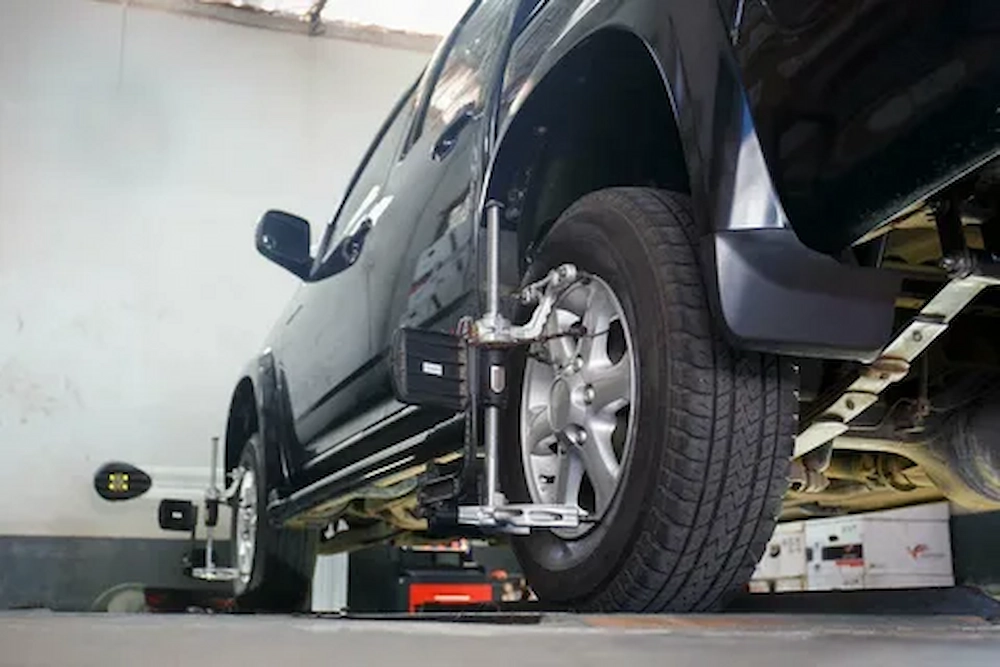
The Effects of Poor Wheel Alignment
The effects of poor wheel alignment can show up gradually, making them easy to overlook until your car’s safety or performance is already compromised. Misaligned wheels affect how your tires meet the road, how your suspension absorbs impacts, and how stable your vehicle feels at different speeds. Over time, the damage extends beyond uneven tires, leading to costly suspension repairs, increased fuel consumption, and serious handling issues.
Common Wheel Misalignment Symptoms
Spotting wheel misalignment symptoms early is key to preventing long-term problems.
The symptoms below often appear after hitting potholes, curbs, or being involved in even a minor accident. In many cases, they also overlap with frame misalignment issues that require precise inspection. Warning signs include:
- Your car pulls to one side when driving straight.
- A steering wheel that sits crooked, even when you’re going forward.
- Uneven or accelerated tire wear, especially on the inside or outside tread.
- Vibrations in the steering wheel at highway speeds.
- Reduced cornering stability or a “loose” feel when steering.
Safety Risks of Bad Wheel Alignment
The safety risks of bad wheel alignment go far beyond uneven tires, they directly affect how your vehicle responds in critical moments. A car that doesn’t track straight or requires constant steering correction may seem manageable at low speeds, but in emergencies, even slight misalignment can be the difference between avoiding an accident and being involved in one.
- Longer stopping distances – Proper alignment ensures that all four tires make even contact with the road surface. When wheels are misaligned, one or more tires lose optimal grip, forcing your brakes to work harder. This can add precious feet to your stopping distance, especially dangerous in wet or icy conditions.
- Loss of stability in emergencies – Sudden lane changes, sharp turns, or evasive maneuvers require precise steering response. With bad alignment, the vehicle may pull to one side, drift unpredictably, or feel “sluggish” when correcting course. These handling issues can cause drivers to oversteer or understeer at the worst possible moments.
- Hidden suspension stress – A misaligned vehicle puts continuous pressure on parts of the suspension and steering systems that weren’t designed for it. Tie rods, ball joints, shocks, and bushings wear out unevenly and much faster, sometimes leading to sudden failures. A broken tie rod or control arm at highway speeds can result in catastrophic loss of control.
- Increased risk during adverse weather – Poor alignment reduces tire traction, which is critical when roads are slick from rain, snow, or ice. A car that pulls to one side or hydroplanes more easily is significantly harder to control.
- Reduced effectiveness of ADAS systems – Advanced Driver Assistance Systems (ADAS), such as lane-keeping assist, adaptive cruise control, and emergency braking, rely on precisely calibrated sensors. If your car’s wheels aren’t aligned, the sensors may not point in the right direction, reducing system accuracy and putting both the driver and passengers at risk.
- Driver fatigue and distraction – Constantly needing to adjust the steering wheel to keep the car straight doesn’t just stress the vehicle, it also stresses the driver. Over long trips, this extra concentration leads to fatigue, slower reaction times, and a higher chance of mistakes behind the wheel.
For vehicles with lightweight aluminum frames or high-tech driver assistance systems, these risks are magnified. Even minor misalignment after a collision can cause hidden structural issues that make driving unsafe. That’s why experts recommend visiting a certified aluminum auto body repair shop or a frame straightening specialist to ensure the underlying structure is sound before any alignment adjustments are made.
In short, wheel alignment isn’t just about keeping your steering wheel straight, it’s about protecting your ability to control the vehicle safely in any situation.
Performance Issues from Poor Alignment
The performance issues from poor alignment affect nearly every aspect of how your vehicle drives. While many people think alignment only influences how straight the car tracks, the reality is that it directly impacts efficiency, comfort, and long-term reliability.
- Reduced fuel efficiency – When wheels are not aligned, they create rolling resistance. This forces the engine to work harder to maintain speed, which in turn lowers miles per gallon. Over thousands of miles, this hidden inefficiency can cost you significantly more at the pump.
- Premature tire wear – Tires are designed to make even contact with the road. Poor alignment puts excess stress on certain edges of the tread, creating bald spots and feathering patterns. Instead of lasting their full lifespan, you may find yourself buying replacements much sooner.
- Strained suspension and steering – Constantly correcting the steering wheel to compensate for misalignment stresses key components such as tie rods, ball joints, and bushings. Over time, this accelerates wear and may lead to sudden failures or costly suspension overhauls.
- Compromised handling – Steering that feels loose, sluggish, or overly sensitive in corners is not just uncomfortable it can also make long-distance driving stressful. On highways, misaligned wheels can amplify vibrations, leaving drivers fatigued much sooner.
- Noise and vibrations – Misaligned wheels can produce humming, squealing, or uneven road noise from the tires. Vibrations in the steering wheel or even the floorboards are another common sign, disrupting both comfort and focus behind the wheel.
- Lower resale value – When a car shows signs of uneven tire wear, poor handling, or steering corrections during a test drive, it immediately signals to buyers that the vehicle may not have been maintained properly. This can lower resale value and make the car harder to sell.
For cars that have been in an accident, these performance issues may indicate deeper frame misalignment or even hidden structural damage that simple tire changes cannot fix. That’s why experts stress the importance of having alignment inspected professionally after any collision, even if it seems minor.
By addressing alignment proactively, you protect both your driving experience and your wallet, ensuring your car remains efficient, comfortable, and safe for years to come.
Why Professional Alignment Checks Matter
While drivers may notice surface-level symptoms, only professional diagnostic tools can reveal the full scope of misalignment. At an OEM-certified collision repair center, technicians use manufacturer-approved equipment to measure angles with pinpoint accuracy. This ensures alignment corrections are done to factory standards, not just adjusted temporarily.
By investing in a professional alignment, you’re not just protecting your car’s handling, you’re also protecting your long-term safety and reducing the chance of hidden issues resurfacing later.
Protecting Your Vehicle’s Safety and Performance
Understanding the effects of poor wheel alignment helps you take action before minor issues grow into serious problems. Whether you’ve noticed uneven tire wear, steering issues, or your car just doesn’t “feel right,” scheduling a check can make the difference between safe driving and costly repairs.
Visit Hyperion Collision Center to learn more about proper vehicle care, or schedule an inspection today to make sure your alignment, and your safety, are on track.


